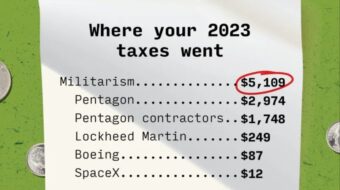
OTTAWA, Ont. (PAI)—South of the border, in the United States, we tend not to pay much attention to our northern neighbors. Entire election cycles can come and go without anyone running for national office saying anything significant about Canada.
But that all changed of late. Canada now looms large in our politics, mainly because many more of us realized Canadians enjoy a health care system far superior to our own, by every meaningful yardstick of fairness and efficiency.
Canada’s single-payer approach to health care has become—for progressives in the United States—a guiding inspiration. We want what the Canadians have. We need what the Canadians have.
We need what Canadians have, an innovative new study suggests, on more than just health care. Average Canadians, this research relates, now enjoy higher incomes than their counterparts in the United States.
The new report—Household Incomes in Canada and the United States: Who is Better Off?—comes out of the Ottawa-based Canadian Centre for the Study of Living Standards and essentially challenges the conventional wisdom on economic well-being. That wisdom, report author Simon Lapointe notes, typically defines well-being as GDP (Gross Domestic Product) per person.
To calculate this GDP yardstick, economists take the sum total of the goods and services a nation produces, divide that total by the nation’s population, and tell us that the resulting number measures how well a nation’s people are doing economically.
By this standard measure, we are doing much better than Canadians. In 2016, the latest year with comparable stats available, GDP per person in the United States ran over 20% higher than GDP in Canada, $57,798 to $47,294, in U.S. dollars adjusted for what economists call “purchasing power parity.”
But that number can obscure reality as most households live it, especially in a deeply unequal society like the U.S. Lapointe acknowledges in his Canadian Centre for the Study of Living Standards report, U.S. households certainly rate as richer than Canadian—on average.
But “much greater incomes at the top of the income distribution” in the United States, he points out, are driving the difference in the Canadian and U.S. averages.
The statistical remedy to the confusion GDP per person creates? Lapointe’s approach divides both the Canadian and U.S. populations “into 100 equal-sized groups, ordered from lowest to highest income,” then compares the actual income for each “percentile” on each side of the Canadian-U.S. border.
“Canadian households with incomes up to the 56th percentile,” Lapointe’s resulting calculations show, “are better off than American households at the same point in the income distribution.”
At the 20th percentile Canadian households pocketed $27,201 in 2016, a substantial $3,786 more than the comparable U.S. household, adjusted for purchasing power parity.
At the 40th percentile, Canadian households made $1,871 more than similarly situated American households. The gap narrows to a $101 advantage Canada at the 56th percentile.
The biggest single percentile difference between Canadian and U.S. households? That comes at the 100th percentile, the top 1%. U.S. households at this lofty level collected $711,801 in 2016, a stunning 57% more than Canadian top 1% households.
“The usual comparison of incomes between Canada and the United States using GDP per capita or average household income hides a critical part of the story,” sums up Lapointe. “U.S. society has greater income inequality, such that the higher average is driven by incomes at the top of the distribution. For poorer or middle-class Canadians, their incomes actually compare favorably to those of their U.S. counterparts.”

Lapointe would be the first to admit that his new research on comparative Canadian-U.S. household well-being has some significant limitations: His numbers only trace “money incomes before tax” and do not factor in “major government transfers in kind—public education, publicly funded health care, and publicly supported housing.”
Canadians today get much more substantial “transfers in kind” from their government than we do, as anyone who’s followed the debate over single-payer now realizes. Higher taxes do, to be sure, accompany Canada’s much more generous social benefits, but the greater overall progressivity of the Canadian tax system, Lapointe observes, “most likely” leaves ordinary Canadians even further ahead of their U.S. counterparts once we factor in taxes and transfers.
What explains the increase in the proportion of Canadian households “better off than their U.S. counterparts”? This increase, concludes Lapointe, reflects “the slower increase in economic inequality in Canada compared to the United States.”
The faster that income and wealth concentrate at the top, in other words, the worse off the daily lives of average people become. Canadians seem to understand this dynamic much more fully than we do. So let’s hope we hear a good bit more about Canada in the 2020 election campaign.












Comments